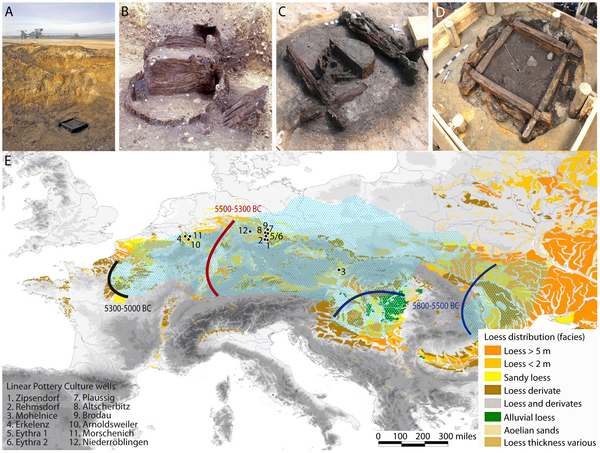Prehistoric farming communities in Europe constructed water wells out of oak timbers - it seems early farmers were skilled carpenters long before metal was discovered or used for tools.
These first Central European farmers migrated from the Great Hungarian Plain approximately 7,500 years ago, and left an archaeological trail of settlements, ceramics and stone tools across the fertile regions of the continent, a record named Linear Pottery Culture (Linearbandkeramik - LBK). However, much of the lifestyle of these early settlers is still a mystery, including the climate they lived in and technology or strategies they used to cope with their surroundings.
According to the study, the oak timbers analyzed in this study are also a new archive of environmental data preserved in the tree rings, which could tell an accurate, year-by-year story of the times these early settlers lived in.

LBK wells from (A) Eythra 1, (B) Eythra 2, (C) Brodau 1, and (D) Altscherbitz. (E) Central European loess distribution [20] with the superimposed phases of expansion of the LBK (lines), based on 14C dates [22], and the maximum extension of the LBK (light blue) along with the 12 known early Neolithic wells featuring waterlogged wood preservation.
doi:10.1371/journal.pone.0051374.g001
They dated 151 oak timbers preserved in a waterlogged environment to between 5469 and 5098 B.C. The most obvious revelation is that the discovery disputes the common belief that metal was necessary for complex timber constructs.
The tree-ring samples from 151 oak (Quercus spp.) in the four water wells at Altscherbitz, Brodau and Eythra had individual ring width measurements covering 371 years, from 5469 to 5098 B.C. and all of the timbers originated from at least 46 mature trees.
The finding also demonstrates neolithic creation of sophisticated corner joints and log constructions.
Citation: Tegel W, Elburg R, Hakelberg D, Stäuble H, Büntgen U (2012) Early Neolithic Water Wells Reveal the World's Oldest Wood Architecture. PLoS ONE 7(12): e51374. doi:10.1371/journal.pone.0051374


